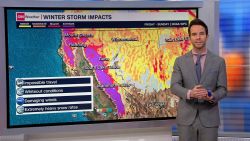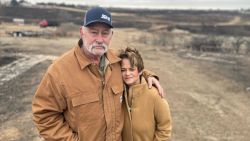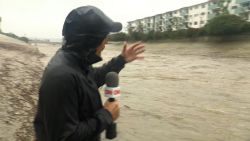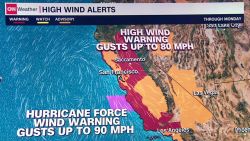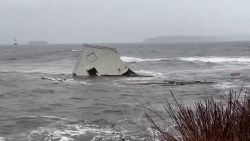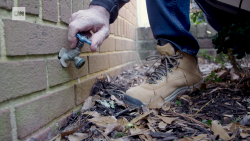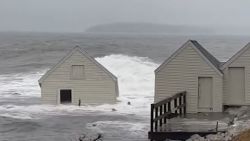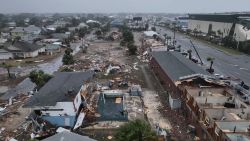A weakened Subtropical Storm Alberto made landfall Monday afternoon in the Florida Panhandle, showering the Southeast with rain and killing at least two people.
The storm is threatening the Southeast with flooding as it is expected to spread moisture across the region into the middle of the week.
Alberto’s winds continued to slow down throughout Monday, reaching maximum sustained winds of 45 mph as it made landfall in Laguna Beach, west of Panama City on the northern Gulf Coast, according to the National Hurricane Center. The winds decreased to 40 mph by Monday night, when the storm was moving north at close to 10 mph.
In Polk County, North Carolina, news anchor Mike McCormick and photojournalist Aaron Smeltzer, of Greenville, South Carolina-based CNN affiliate WYFF, were killed Monday when a tree fell on their SUV as they covered the hazardous weather, the station said.
North Carolina Gov. Roy Cooper said the two died due to storm-related conditions. “North Carolina needs to take Alberto seriously,” Cooper said in a news release.
Alberto also disrupted Memorial Day plans in Alabama, Florida and Mississippi as it moved into the Southeast.
Instagram user Melody Kay Carroll posted a video clip of wind and rain in a Panama City parking deck. “Strong squalls off and on” had kept her inside, she said.
States prepare for storm
The heaviest rain bands and strongest winds began coming ashore around 10 a.m. Monday in Panama City Beach.
A Tropical Storm Warning is in effect for the northern Gulf Coast from the Aucilla River west to the Okaloosa/Walton County line, the National Hurricane Center said in its 8 p.m. ET update.
The three states likely to bear the brunt of the storm have been preparing states of emergency.
Florida Gov. Rick Scott issued a declaration for all 67 counties in his state. Mississippi Gov. Phil Bryant authorized the use of the National Guard, his office said.
Alabama Gov. Kay Ivey issued a state of emergency for 40 counties, starting at 6 a.m. Sunday. Ivey activated the state’s emergency operations center while the Alabama National Guard activated its high water evacuation teams.
The storm’s center is expected to move over Alabama on Monday night and Tuesday, the NHC said. The forecast projects the system moving over the Tennessee Valley on Tuesday and into the Ohio Valley and Great Lakes region on Wednesday and Thursday, the center said.
Flash flooding risk
Flooding and flash flooding are possible in the Southeast, including Florida, the NHC said in its latest update.
Alberto could bring isolated storm totals up to 12 inches in areas of the Florida Panhandle into much of Alabama and western Georgia through Tuesday, the NHC said. The Florida Keys and Florida peninsula could receive up to 5 inches of rain in some areas.
“Heavy rainfall will lead to a significant risk of flash flooding across the Florida Panhandle, much of Alabama, and western Georgia through tonight, spreading northward into northern Georgia, the western Carolinas, and Tennessee on Tuesday,” the NHC said.
The National Weather Service said 2 to 6 inches of rain are expected in the rest of the Southeast and the Tennessee Valley into the lower mid-Atlantic from Tennessee east through the Carolinas.
“The combination of storm surge and the tide will cause normally dry areas near the coast to be flooded by rising waters moving inland from the shoreline,” the NHC said, with water potentially reaching 1 to 3 feet above ground if the peak surge occurs during high tide.
Isolated tornadoes possible
Isolated tornadoes are likely through Monday night in parts of Georgia and southeastern Alabama, the NHC said.
“Alberto will likely become a subtropical depression tonight or early Tuesday and degenerate into a remnant low by Tuesday afternoon,” the NHC said.
Authorities in New Orleans urged residents and businesses to “get prepared and stay informed” about the storm. The main threat is from heavy rain that could lead to flooding, the city said, but also high winds and storm surge could cause problems.
“I strongly encourage everyone to be safe and stay informed,” Mayor LaToya Cantrell said in a statement.
Hurricane season doesn’t officially begin until June 1, but Alberto apparently missed the memo. The tropical system became a subtropical storm Friday, the National Hurricane Center said.
The early storm doesn’t necessarily mean this year’s hurricane season will be as busy as last year’s, though. The season is likely to be “near or above normal,” according to the NHC.
CNN’s Taylor Ward and Janet DiGiacomo contributed to this report.



